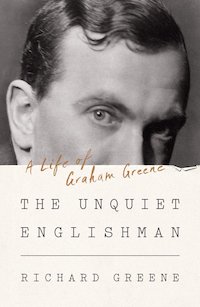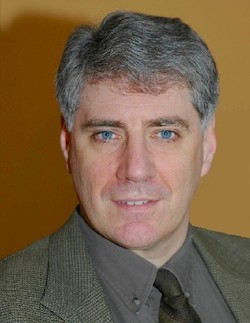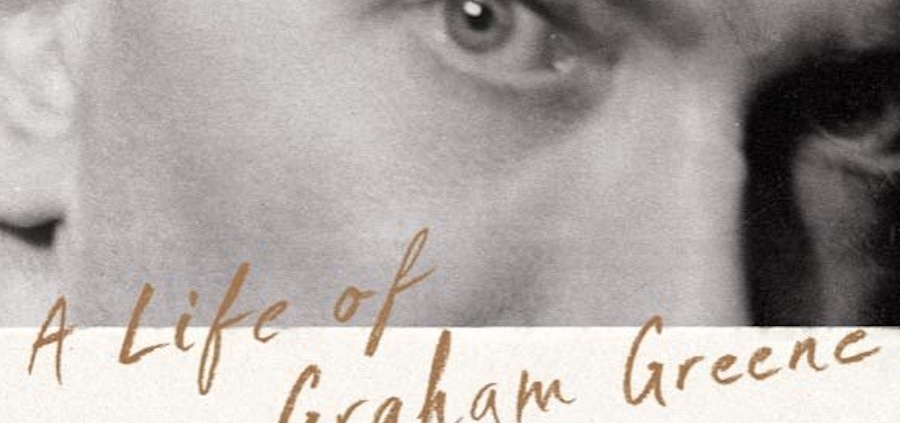The Catholic Agnostic by Frank Freeman
 The Unquiet Englishman:
The Unquiet Englishman:
A Life of Graham Greene
By Richard Greene
W. W. Norton, 2021
$40 608 pp.
Sometimes it seems Graham Greene (1904–1991) was, with his psychology, destined to become a spy. This was akin, he often wrote, to being a writer (and he was both, though far more successful as a writer). His father was headmaster at the school he attended, Berkhamsted in Hertfordshire. Torn between loyalty to his friends and to his father, and especially tortured by two bullies named Carter and Wheeler, he one day disappeared from school and was found sitting recalcitrant and incoherent in the nearby woods.
Richard Greene (no relation), professor of English at the University of Toronto, does a fine job of exploring what he calls the “life and times” of Graham Greene. “Here is a single life on which much of the history of a century is written,” he says of his subject. He also gives us a sense of what drove the novelist’s inner life. Eric Strauss, a psychoanalyst and Jewish Catholic convert, once diagnosed Greene with manic depression. This insight allows the biographer to explore Greene’s private character with more compassion and less prurience than that of past biographers.
We do not possess Greene’s psychiatric records, so caution needs to be exercised. And yet there is no denying that his moods were extreme and variable—he could be by quick turns irritable, wildly playful, urgently sexual, or suicidally depressed. Journalists looking for easy copy have sometimes condemned Graham Greene’s character, but the disasters, especially of his marriage and sexual life, are generally more pitiable than culpable. Indeed, his survival itself is something of a triumph, for, as Dr. Kay Redfield Jamison, an expert on bipolar illness, has observed, given his early behaviour it is remarkable he did not succeed in killing himself.
This latter point is evidenced not only by Greene’s youthful solitary playing of Russian roulette (though there is some doubt about how dangerously he really did so), jabbing his knee with a knife, and attempting suicide once or twice with pills, but also by his lifelong penchant for traveling to the world’s geopolitical hotspots just as they were exploding: places such as Liberia, Mexico, Sierra Leone, Kenya, Vietnam, Haiti, and Panama, to name just a few.
And yet he kept on living and working, saying acts of contrition in helicopters he thought were going down and writing 500 words a day, though there were times he wrote much more than that and used Benzedrine to keep himself up to work on two books at a time. Before all this he had fallen in love with a Catholic woman, Vivien Dayrell-Browning, and converted to Catholicism under the instruction of Father George Trollope, who had given up a promising acting career to become a priest. Greene and Vivien had two children, Caroline and Francis, but Greene was unfaithful, full of wanderlust, and rarely home after the first few years of marriage. He always provided well for his family (and many of his extended family as well as friends and former lovers, which meant he experienced chronic financial worries), and after working a few years as a journalist his novel-writing career took off. He always attended Mass, although at some point he gave up going to confession and receiving the sacraments.
The great love of his life was Catherine Walston, who is immortalized as Sarah in the 1951 novel The End of the Affair. They were lovers off and on for years, secretly made vows to one another, and attended a Mass said by Padre Pio (with whom Greene refused to speak privately because, he admitted, he didn’t want to be encouraged to change his lifestyle). But in the end Walston refused to leave her husband and children while Dayrell-Browning refused to grant Greene a divorce or to start annulment proceedings. She later admitted she wanted to punish him.
During World War II, the British intelligence agency MI6 recruited Greene as a spy. It was mostly routine work, but it fascinated Greene and he found he had a proficiency for it. One of his supervisors was the notorious Kim Philby, who had been working in British intelligence on behalf of the Soviet Union for years. Greene was one of the few people who continued to support Philby even after his defection to Moscow; he said that if Philby had done it just for money he would have despised him, but Philby was a true Marxist and so was working for a cause. As Richard Greene notes, Philby had a lot of blood on his hands, but this never seemed to bother Greene. He did, however, always speak out against Soviet oppression, as well as against the United States, which he thought was an equally negative influence on the world.
Fascinating as this backstory might be, we read a biography of Greene not because he was a spy, but because he wrote great novels. Early in his literary career, he distinguished between “entertainments” such as The Confidential Agent and The Ministry of Fear and his “regular” novels. According to Richard Greene, this was rather a tenuous distinction that even the author himself came to doubt. Some of his novels deal with explicitly Catholic themes, such as Brighton Rock, The Power and the Glory, and The Heart of the Matter. Later in his career, though his preoccupation with belief and faith was still evident, his work became more political in novels such as The Quiet American, The Honorary Consul, and The Human Factor. He also showed a flare for comedy in works like Our Man in Havana and Travels with My Aunt.
Greene disliked it when people called him a “Catholic novelist”; he preferred to say he was a novelist who happened to be a Catholic. He was a master craftsman, not a stylist, who could tell a gripping story. Often these stories centered around an act of betrayal that was perpetrated for a higher cause. Greene once stated that one comes to a point where one has to choose sides, and he always chose the side of the oppressed. As Richard Greene notes, “He had once spoken of his own duty in ‘The Virtue of Disloyalty,’ a lecture given in Hamburg in 1969: ‘the writer should always be ready to change sides at the drop of a hat. He stands for the victims, and the victims change.’”
Complicating this is the sense the reader sometimes feels while reading Greene that his characters have given in to the temptation to play God. They grow impatient with God’s slowness to act, and so they choose to do something, anything, even betray someone they love, to make things happen. This is a kind of particularly gnostic temptation, to take control of life in the face of what seems like God’s absconding from the world. And it can be the flipside of the coin of commitment.
Two of the most memorable criticisms of Greene came from George Orwell and Robert Stone. Orwell savaged The Heart of the Matter in a review (he seems to be one of the few who disliked it), saying that in Greene’s novels everyone is quick to fall in bed with the first available person but with apparently no enjoyment on either side. Stone said he disliked Greene’s work because he always put a thumb on the scale; he didn’t play fair as a maker. These critiques do point to faults in Greene’s books, but this biography shows that they are intertwined with certain fault lines in Greene’s psyche and do not detract from his work’s ultimate worth. Greene was promiscuous but felt guilty about it; as for putting his thumb on the scale, this is partly a measure of his commitment to causes, something which every writer has to decide for themself.
Towards the end of his long life, Greene settled in Antibes with a French woman named Yvonne Cloetta. He showed much courage (as he had all his life, sometimes foolishly so) in standing up in the press and in person to Yvonne’s daughter’s abusive husband, a member of the local mafia, and slept for a while with a revolver under his pillow. He was friends with a traditional Spanish priest with whom he toured Spain many times; these journeys provided him with the raw material he shaped into Monsignor Quixote, a novel about a loveable, ingenuous Spanish priest who travels around in a battered car named Rocinante with his best friend, a Communist mayor. In the novel, the monsignor gives communion to his friend; in real life, Greene also returned to the sacraments as he approached death.
Greene’s view of Catholicism was complicated. He called himself “at the worst a Catholic agnostic.” Richard Greene explains:
The “agnostic” part of that formulation had to do with the reasoning side of Christianity. In his late years, Greene followed closely the writings of the theologian Father Hans Küng, best known for Infallible? An Inquiry, which offered a tough critique of the fundamental claims of the papacy, after which the Vatican withdrew his credentials as a Catholic theologian. Graham Greene was strongly influenced by ideas, and they exchanged letters in 1989, with the novelist expressing gratitude to Küng “for helping me to keep one foot in the Catholic church.”
On the other hand, the biographer notes,
Greene’s theological views were surprisingly conservative. He did not admire the Dominican theologian Father Edward Schillebeeckx because his account of the Resurrection was overly figurative: he spoke of Easter occurring in the experience of the disciples. For Greene, the Resurrection, if it occurred at all, had to involve an empty tomb, and he pointed to the account in John’s Gospel as having the veracity of good journalism, as the sprinting John comes to the tomb first and stops, while Peter rushes in. This was a human touch that fable or myth would be unlikely to generate.
As someone who once hurled Greene’s first novel, The Man Within, across the room, despite having been a fan of his for years, this biography reminded me of why I was originally drawn to his work. Richard Greene has done a fabulous job of portraying a complex man with a life more eventful than most writers, much less most men of action. I’m not sure how he was able to corral all of this material into just over 500 pages of text, but he has done so in a wonderfully readable way. If one is further interested in Greene, I might also recommend two books about him by fellow writers: The Man Within My Head by Pico Iyer and Greene on Capri: A Memoir by Shirley Hazzard.
Perhaps the passage that best characterizes the work and themes of Graham Greene comes from an early novel, Brighton Rock, about a group of gangsters in the English seaside resort town. At the end of the novel, a character tells a priest she believes she should die without the sacraments so as to be faithful to a lover who had died in a state of mortal sin. The priest tells her the story of the French poet Charles Péguy. Choosing to be on the side of the damned, Péguy refused the sacraments was eventually killed in battle outside of Villeroy, France, in 1914. The priest adds: “You can’t conceive, my child, nor can I or anyone the . . . appalling . . . strangeness of the mercy of God.”
“A Question of Vantage”:
Frank Freeman in Conversation
with Richard Greene
I’m wondering what you think of what I said in my review of how Greene’s characters sometimes succumb to the temptation to play God. Do you agree? Is this just that we have to decide at some point what side we’re on? Or can this temptation be a sin, in a sense?

Richard Greene
I think your point is very interesting. As a result of his bipolar illness, Greene found any form of waiting very difficult—he was profoundly restless. I can’t think of an example in his work of a character resignedly waiting on providence. On the other hand, he tended to regard uninvolvement or apathy as one of the worst sins. In The Quiet American, it is said that we must choose sides in order to remain human. In The Comedians a priest gives a funeral sermon on the saying of Saint Thomas, “Let us go up to Jerusalem and die with him.” Greene’s exposure to battlefields and repressive systems taught him to distrust a piety that watches other people die and does not lift its hand. I think he would turn the proposition around and say that too many religious people merely play at being human. On the other hand, Greene did read spiritual works about resignation to the will of God, but he found it a struggle.
How did you come to be interested enough in Greene’s work to write a biography of him? Was there any certain book that galvanized you?
I’ve been reading Graham Greene with fascination since I was 15. The book that most moved me was The Power and the Glory. My decision to work on him proceeded from an invitation by his literary estate, knowing of my work on his early mentor Edith Sitwell, to edit his letters, and from there it seemed logical to attempt a full biography as I was already immersed in the sources.
I think your time in a Jesuit seminary may have enabled you to be sensitive to some of the theological subtleties in Greene’s work others have missed. Did your Jesuit training help you in any other way in writing this book or understanding Greene?
It is kind of you to say so. I was a Jesuit novice, not a seminarian, and left without taking vows. However, that period of my life, which I treasure, did cause me to absorb Ignatian spirituality and also to learn a good deal about theology and modern scripture scholarship. In particular, I became very interested in liberation theology which figures in the last quarter of the book. Many Jesuits appear in the book because Greene sought the friendship of learned priests, and he was especially moved by the work of priests and nuns among the poor of Latin America, often at the risk of their lives.
Can you comment on the whole concept of “Greeneland,” the term for any politically unstable world reminiscent of the settings of Greene’s novels? I read somewhere he hated that moniker, but it does seem applicable. I remember the section in your biography describing his passing through San Antonio and how American society didn’t seem real to him. Is Greeneland more real?
He thought that Greeneland was something critics dreamed up, as they had not travelled with him to the desperate places of the world and seen what he had seen. A reviewer once asked him why he set his stories in such places and he responded, “It’s a restlessness that I’ve always had to move around, and perhaps to see English characters in a setting which is not protective to them.” This is important—something of human nature becomes visible when we no longer have our privileges and protections. Think of the whisky priest in The Power and the Glory listening to the voices of desolate men and women at night in a prison cell. Or, as Scobie in The Heart of the Matter speaks of Sierra Leone: “Here you could love human beings nearly as God loved them, knowing the worst.” It is a question of vantage. He goes where he believes he can see most clearly.
Frank Freeman’s work has been published in America, Commonweal, Dublin Review of Books, and the Weekly Standard, among others. He lives in Maine with his wife and four children, dog, cat, and four chickens. He hopes to have his books published some fine day.





Leave a Reply
Want to join the discussion?Feel free to contribute!